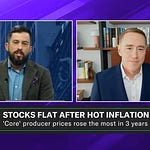Here’s the transcript from my interview with Yahoo Finance, edited for brevity.
Yahoo Finance: Investors have been in the throes of tariff policy whiplash, Fed decision, and earnings reports. Constant uncertainty keeps it interesting, of course, but uneasy when it comes to managing portfolios.
Our next guest is no stranger to navigating these conditions. We're joined now by Charles Sizemore. Welcome, Charles to the show.
I'm gonna start, Charles, where you see opportunity right now. We have, we do have some smart folks, Charles, strategist, CIOs, they come on the show and, and they do see opportunity overseas, specifically in Europe, and it sounds like Charles, you agree with that call.
Charles: 100%, and it's not that I'm bearish on the US and with the entire tariff trade war here essentially on pause for the next 90 days. The biggest impediment to the US market going higher has been resolved.
But the, the bigger question of course is who is really in the wings waiting to buy the US market. Everyone is already overweight, whether you're talking about mom and pop investors or multi-billion dollar pension funds. The US — and specifically US tech — has been their biggest holding.
If you're any investor, whether retail or institutional, you're going to note that you don’t have a lot of exposure to Europe right now or to emerging markets.
Suddenly it makes sense to reallocate.
It is worth noting the the like a broad basket of European stocks, you know, just take a Vanguard ETF for example, is up about 17% year to date, whereas the S&P 500 is flat.
Yahoo Finance: Is the European trade potentially being overplayed, because to your point we've already had a lot of gains year to date? And are there any specific stocks or sectors that you are looking at that you think still have a little bit more room to run in the Europe trade?
Charles: Yeah, sure, but before I get into that, I think it's really untrue that the Europe trade is long in the tooth. Look at the 2000 to 2007 window. European stocks beat the pants off the S&P 500, and that was, that was a long stretch. We're talking about seven years there. Whereas the outperformance today is measured in months. But drilling down, what specific sectors look really good?
Defense.
Europe and the US have really diverged. Their interests are no longer aligned. If Europe wants to project power, wants to project influence, they're going to have to do it themselves.
That means they are rearming.
Just this week, the various members of NATO were talking about increasing defense spending to up to 5% of GDP.
That's a stretch.
I don't know that they'll ever get that high, but you are still, regardless, looking at a major investment in defense, and the European countries are going to be more likely to buy that at home.
They're more likely to look to their domestic defense contractors as opposed to looking at ours.
Yahoo Finance: And Charles, let's talk gold as well here. Maybe the US-China trade truce is a boost to risk assets but put a dent in gold’s shine?
You still though like gold long term. How come?
Charles: Gold is a multi-purpose hedge. It's an inflation hedge, of course. That’s less critical today because inflation's starting to to come down. Inflation is nearly to the Fed's target.
Gold is also a crisis hedge, and we saw it really benefit from that in April, of course. When it looked like the world was ending, gold did phenomenally well. Well, now all that's on pause for the next 90 days.
But what else is gold a hedge for?
The dollar.
It's, it's a hedge for currency risk. Similar to the factors driving portfolio managers to reallocate their stock portfolios, central banks and international players are also reassessing their currency risk.
You don't have to have them flee the dollar. You just have to have them slightly diversify across other currencies and gold for that to really move the metal.
So, I'm still a gold bull and probably will be for the rest of this year.





